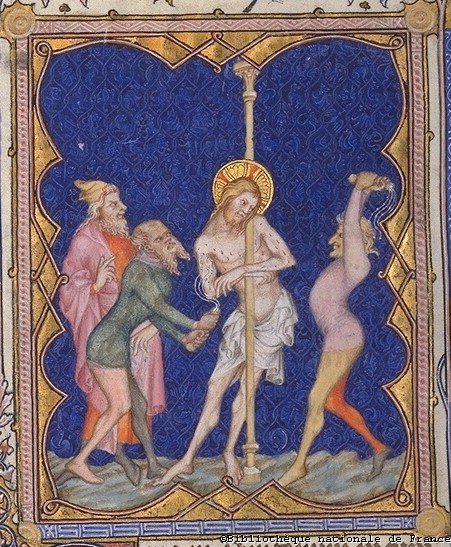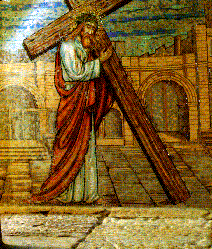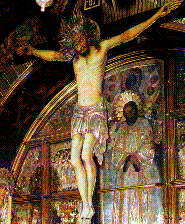hanging ’round your neck?
Tell me, is there
meaning in that crucifix? (1)
 It seems that crosses have really become a big-time fashion accessory. Crosses are often displayed on clothing or hung on necklaces or worn as earrings or other forms of jewelry. Even though it seems pretty fashionable right now to wear crosses as jewelry, The Doctor sometimes wonders if people who display crosses in this manner are really familiar with the horror of what it represents. At this time of year when we celebrate Jesus’ death, burial, and resurrection, maybe it’s time to take a closer look at what the cross really represents by looking at the experience of the One most closely associated with it- Jesus Himself.
It seems that crosses have really become a big-time fashion accessory. Crosses are often displayed on clothing or hung on necklaces or worn as earrings or other forms of jewelry. Even though it seems pretty fashionable right now to wear crosses as jewelry, The Doctor sometimes wonders if people who display crosses in this manner are really familiar with the horror of what it represents. At this time of year when we celebrate Jesus’ death, burial, and resurrection, maybe it’s time to take a closer look at what the cross really represents by looking at the experience of the One most closely associated with it- Jesus Himself.
“…And (Pilate) ordered Jesus flogged with a leaded whip, and ordered Him over to be crucified.” (Mark 15:15)

The gospels tell us that Jesus was beaten by the Roman soldiers before going to the cross. This beating, called a scourging, usually came before the actual act of crucifixion. A “scourge” was a whip, consisting of a handle with three lashes or strips of leather with sharp pieces of bone or metal often attached. Scourging a prisoner helped eliminate their ability to resist crucifixion and it also served as something of a sadistic sport for hardened Roman soldiers.
The normal procedure was to strip the victim of their clothes and tie their hands above their head to a support column. Two soldiers (called lichtors) were positioned on each side of the prisoner. Each soldier would then take alternate turns whipping the victim. With each strike, the embedded metal within the scourge would tear into the victim’s body and rip out small bits of flesh. This thrashing continued until it appeared that the prisoner was near death.
Although the Jewish people were limited to 39 lashes when whipping a prisoner (see 2 Corinthians 11:24), the Romans were under no such conditions. When it came to scourging, there was only one Roman limitation- the prisoner had to be kept alive to carry their cross.
This area of the palace (known as the Praetorium) was the place where the Roman troops were housed. It was here that the soldiers in charge of Jesus began to make fun of Him and His claim to be a king. They went to great lengths to humiliate Him by spitting on Him and dressing Him up in purple, the color of royalty. They twisted a crown made from thorns -a mock symbol of authority- and jammed it onto His head. They gave Him a reed, or cane as a sort of “Royal Scepter”, and then beat Him with it. The entire garrison, or the entire battalion of soldiers, was there to witness this humiliation
“They took Jesus therefore, and He went out bearing His own cross, to the place called the Place of a Skull, which is called in Hebrew, Golgotha” (John 19:17 RSV).
Typically, the condemned prisoner was made to carry the crossbar that they were to be crucified on to the place of their crucifixion. In Jesus’ case, the beating He had sustained weakened Him to the point that He was unable to carry His cross all the way to the place where He was to be crucified. So a guy off the street -Simon of Cyrene, who was just coming into town- was made to carry Jesus’ cross to the place of His execution (Mark 15:21).
“There they crucified Him and two others with Him, one on either side, with Jesus between them. And Pilate posted a sign over Him reading, ‘Jesus of Narazereth, The King of the Jews.’ The place where Jesus was crucified was near the city; and the signboard was written in Hebrew, Latin, and Greek, so many people read it” (John 19:18-20).

Upon arrival to the site of crucifixion, the prisoner would be stripped of their clothes and bound with ropes or nailed to the crossbar that they had carried. Those who were nailed to their crosses, as Jesus was, were secured with large spikes -7 inches (18 cm) long, and 1/3 inch (.75 cm) wide at the head- driven into the upper wrist area at the base of the hand.
After this, the crossbar (called a patibulum) was fastened onto a vertical pole into which the victim’s feet would be nailed. The remains of first century crucifixion victims found near Jerusalem indicate that the feet of the crucified were held to their crosses through a single nail driven through the heel area. A statement of the charges against the person who was being crucified was usually nailed to the pole above the victim’s head. In Jesus’ case, it read: “The King of the Jews“, the description of His “crime.”
“And the people passing by hurled abuse, shaking their heads at Him and saying, ‘So! You can destroy the Temple and build it again in three days, can you? Well then, come down from that cross if you are the Son of God!’
And the chief priest and Jewish leaders also mocked him. ‘He saved others,’ they scoffed, but He can’t save Himself! So, you are the King of Israel, are you? Come down from the cross and we’ll believe you! He trusted God- let God show His approval by delivering Him! Didn’t He say, ‘I am God’s Son?'” (Matthew 28:39-43).
As the prisoner hung on his cross, his respiratory muscles would slowly lose their ability to function. Although air could be drawn into the lungs, it couldn’t be exhaled properly. To breathe, the victim would have to push themselves up against the nail that held their feet; failure to do so would result in suffocation. Muscular cramping was severe; thirst was intense. Insects would gather around the victim, especially if they had been hanging for an extended period. Birds of prey could easily swoop down and peck at the wounds of the defenseless victims. This is how the crucified would spend their final hours.
“And Jesus, crying out with a loud voice, said, ‘Father, into thy hands I commit my spirit.’ And having said this, He breathed his last” (Luke 23:46 RSV).
 So why did Jesus do it? Why did He permit Himself to be executed in such a horrifying manner? Well, the answer is that Jesus sacrificed himself to provide for our atonement. “Atonement” is just a fancy way to describe the act by which God restores a relationship of unity between himself and human beings. In the Old Testament, this atonement was accomplished through a system of animal sacrifices. In other words, instead of paying for their own sins by their own death, the sacrifice of an innocent animal was accepted by God in place of the person who brought it.
So why did Jesus do it? Why did He permit Himself to be executed in such a horrifying manner? Well, the answer is that Jesus sacrificed himself to provide for our atonement. “Atonement” is just a fancy way to describe the act by which God restores a relationship of unity between himself and human beings. In the Old Testament, this atonement was accomplished through a system of animal sacrifices. In other words, instead of paying for their own sins by their own death, the sacrifice of an innocent animal was accepted by God in place of the person who brought it.
This system allowed people to get right with God but it only worked temporarily. Because people constantly sin (sometimes even when they don’t realize it) another sacrifice would then be required and then another and another which resulted in a continuing cycle of sin/sacrifice. This is why Hebrews 10:4 says, “it is impossible for the blood of bulls and goats to take away sins.” This system of sacrifice could not take away sins, it could only cover them up.
This is why Jesus bore the penalty that we deserved for rebelling against God. He provided Himself as a sacrifice once for everyone! Remember that wherever there is sin, punishment has to take place- and that punishment is death (See Ezekiel 18:4). But Jesus died in your place. His was the ultimate sacrifice- one that not only cover sins but takes them away like a wave that sweeps in and carries a ship out to sea. When we accept Christ and acknowledge Him as Lord and Savior, we personally identify with His sacrifice on the cross by accepting it in place of the punishment we deserve.
So Jesus took the death penalty in our place. Those who believe and trust in what He did are not only freed from sin’s death penalty but are also restored to a right relationship with God through His sacrifice. This is the true meaning of the cross.
(1) Value Pac, Sunday Christian from their self-titled CD
The religious art seen above appears through the courtesy of Christus Rex

